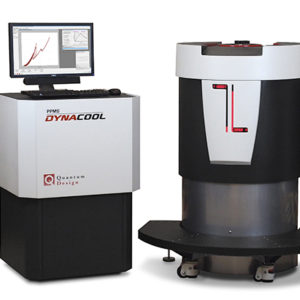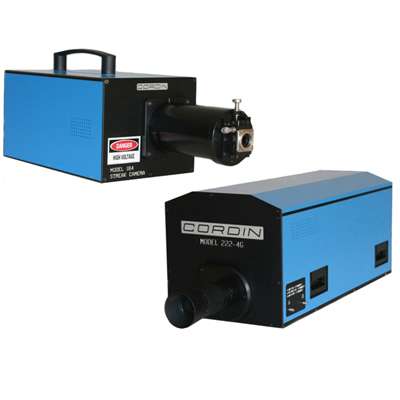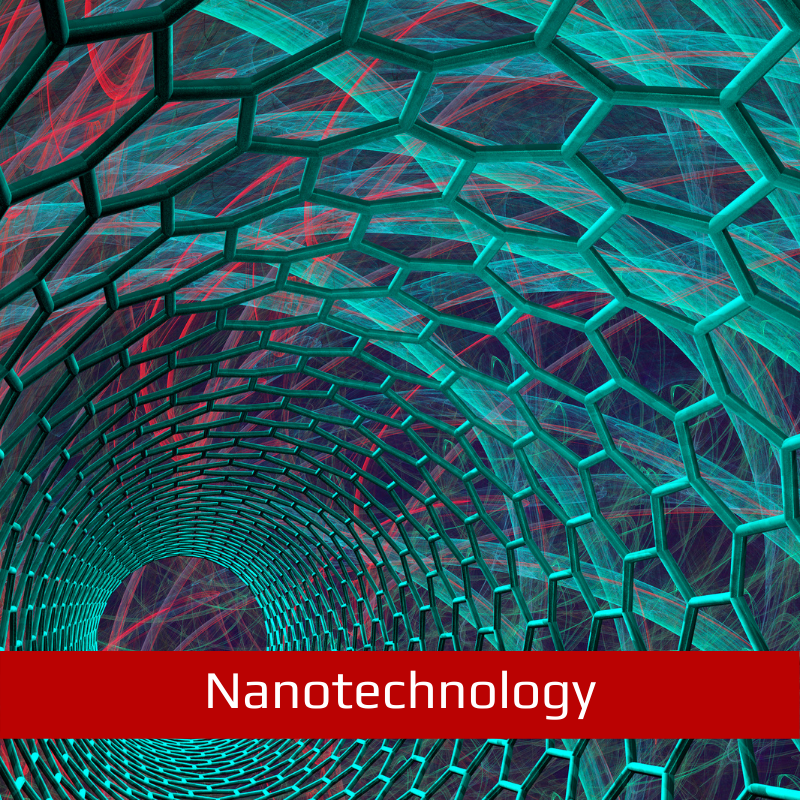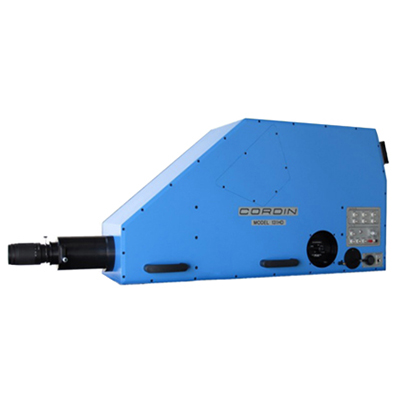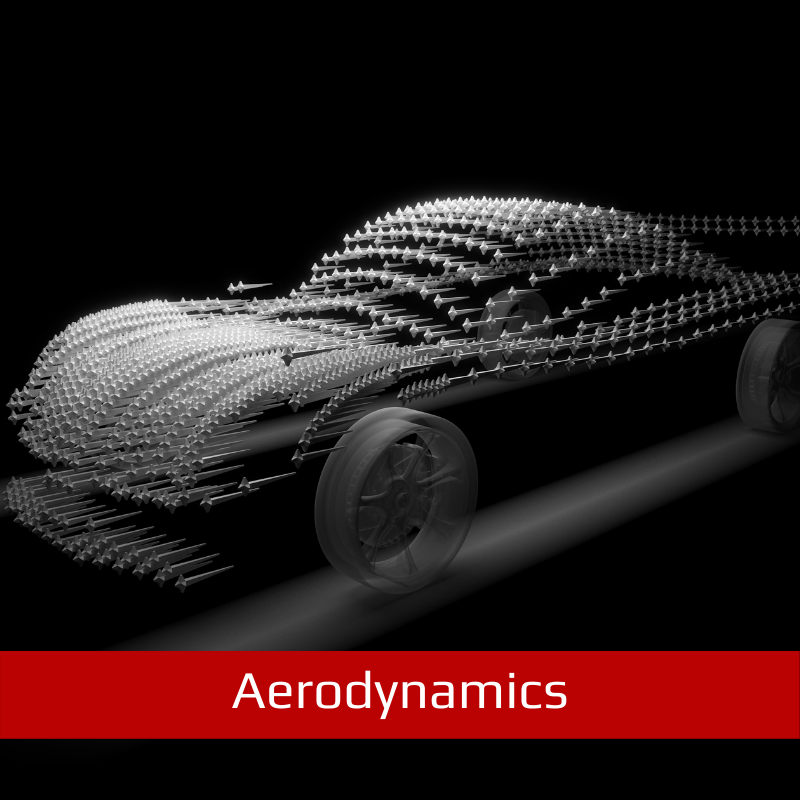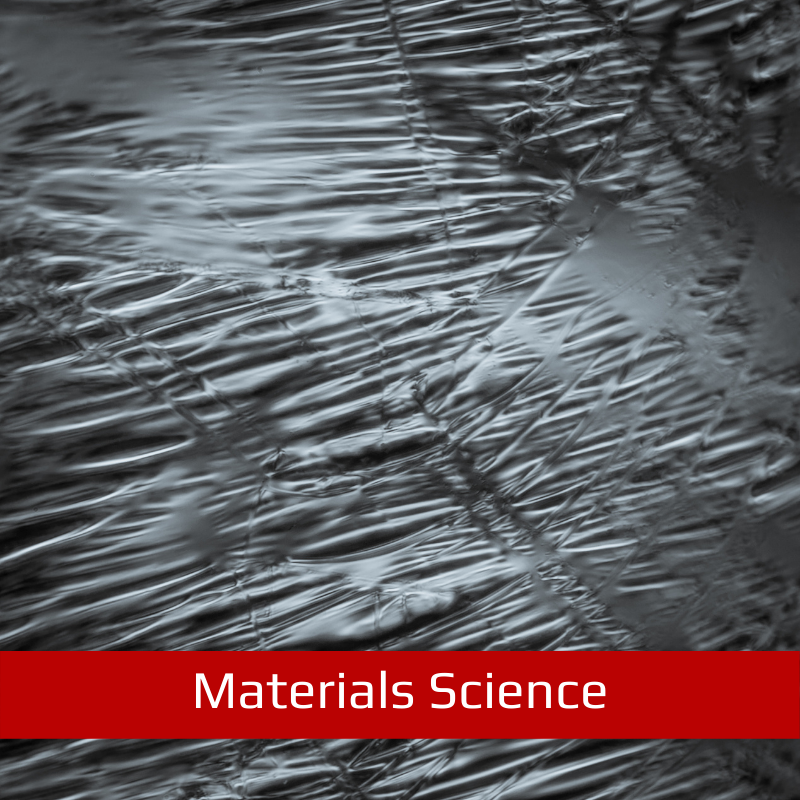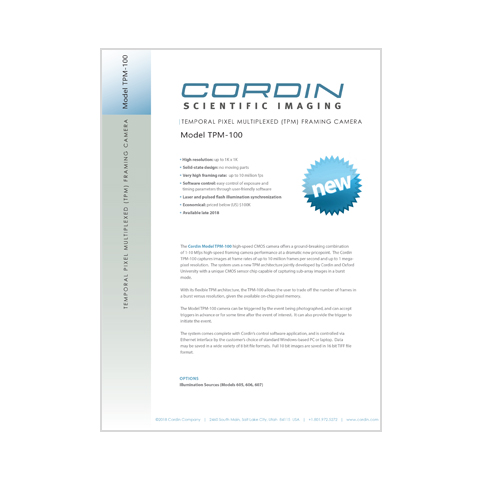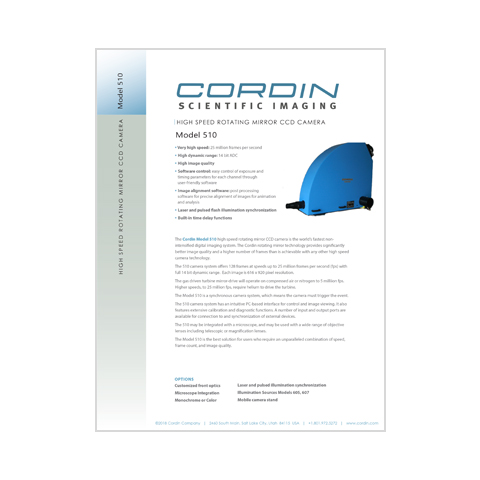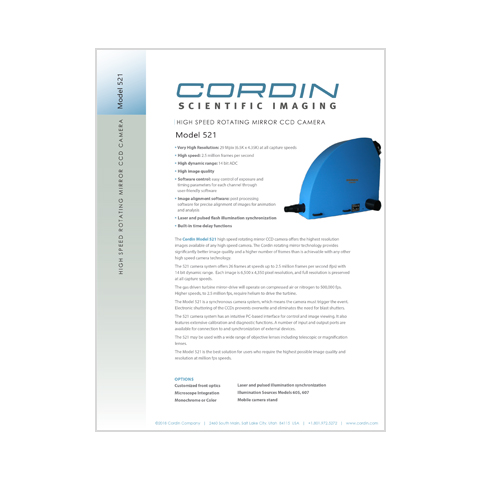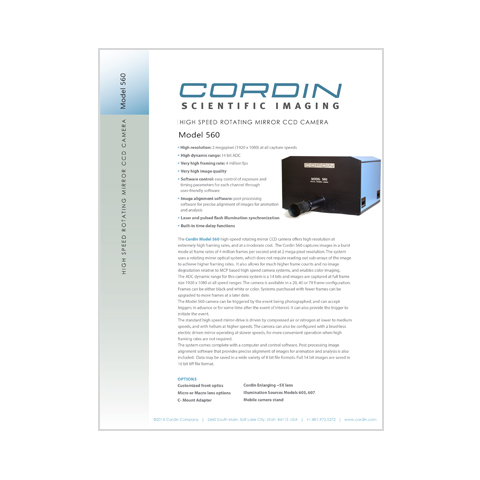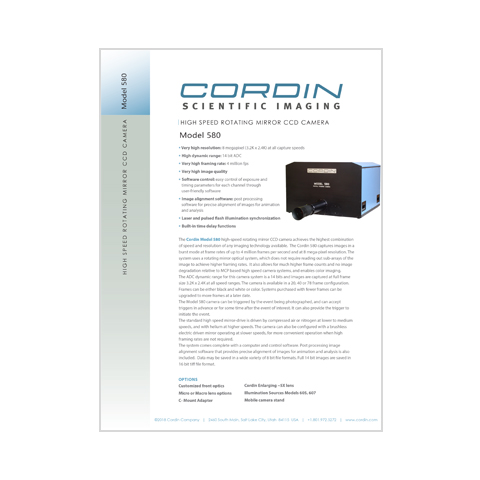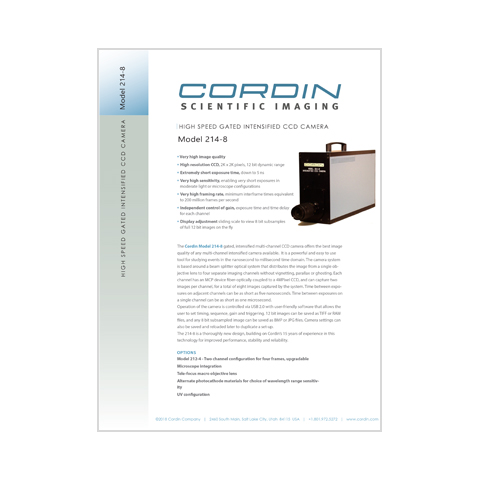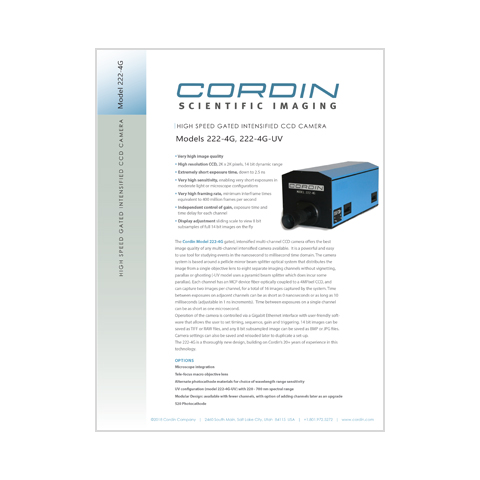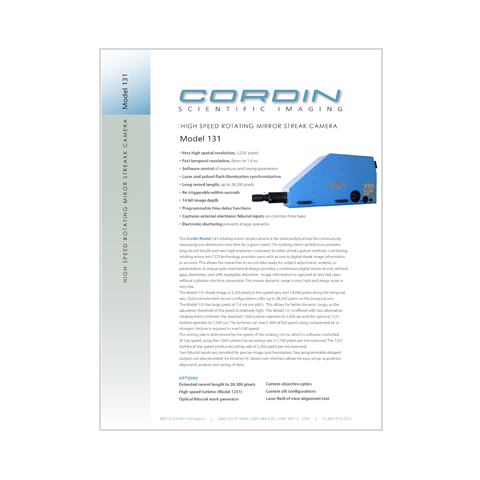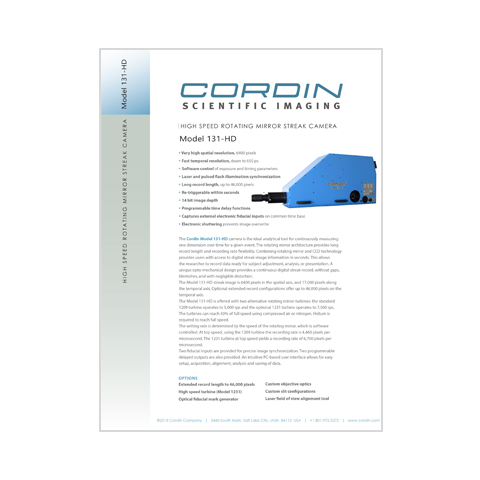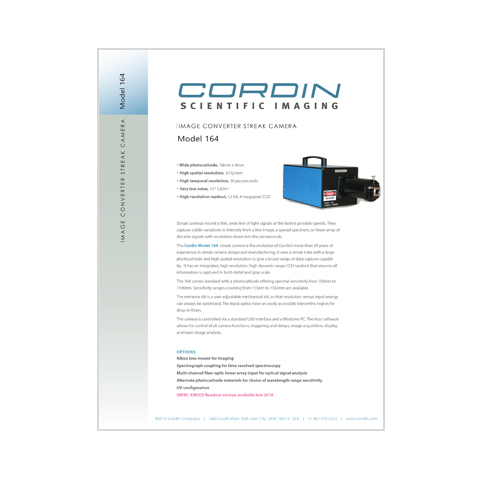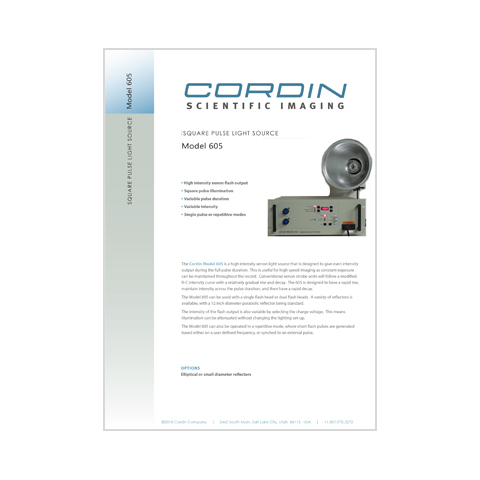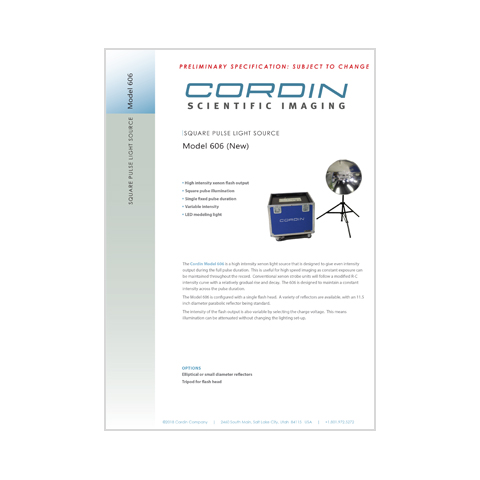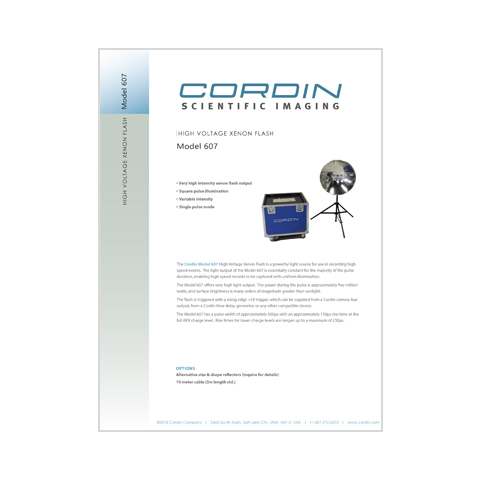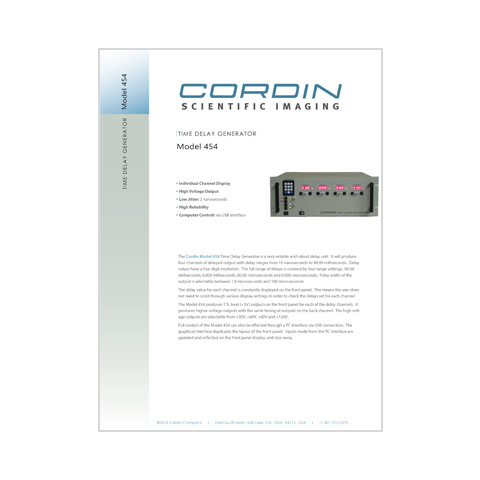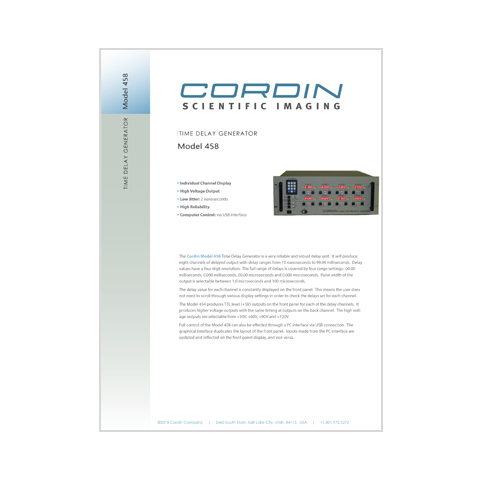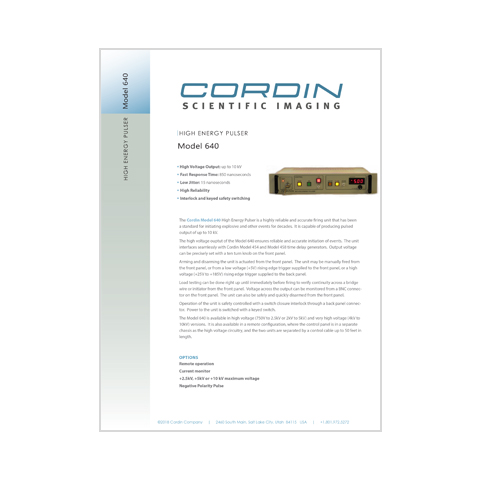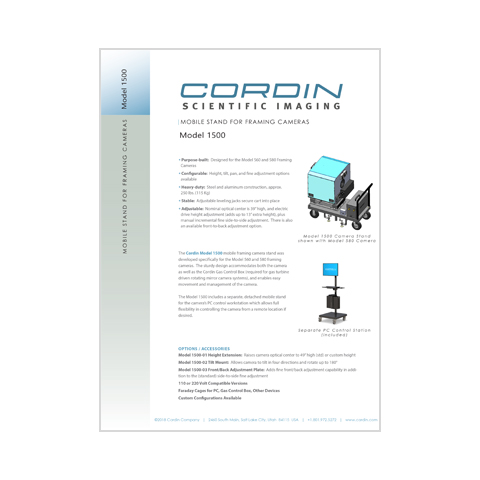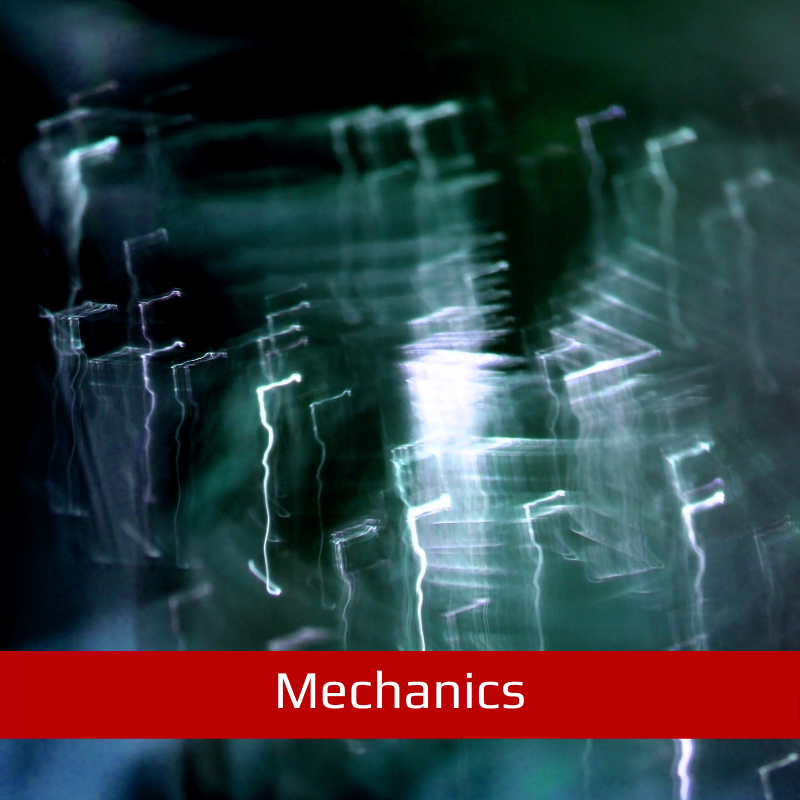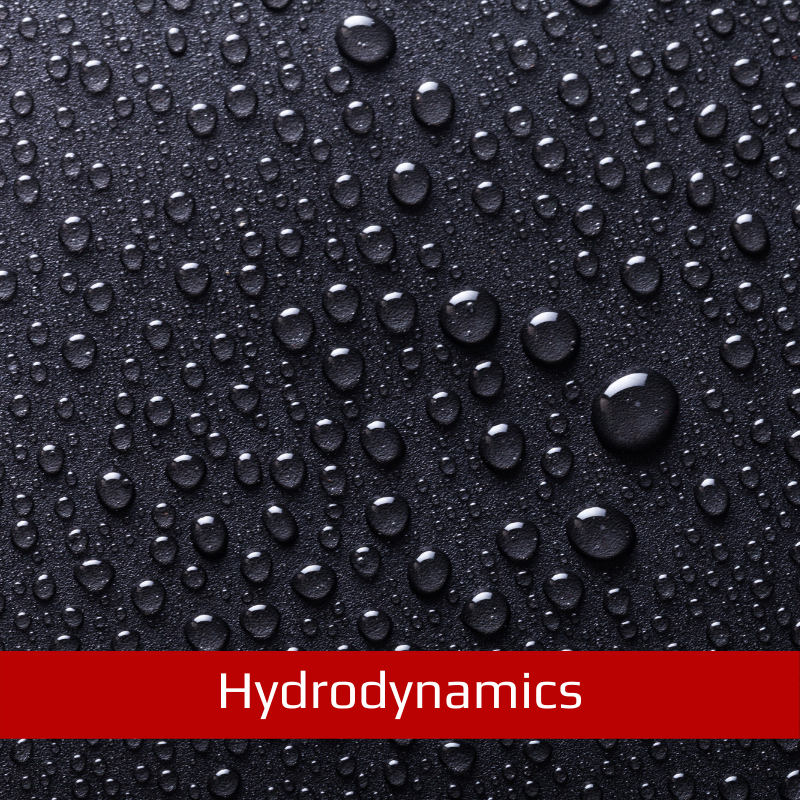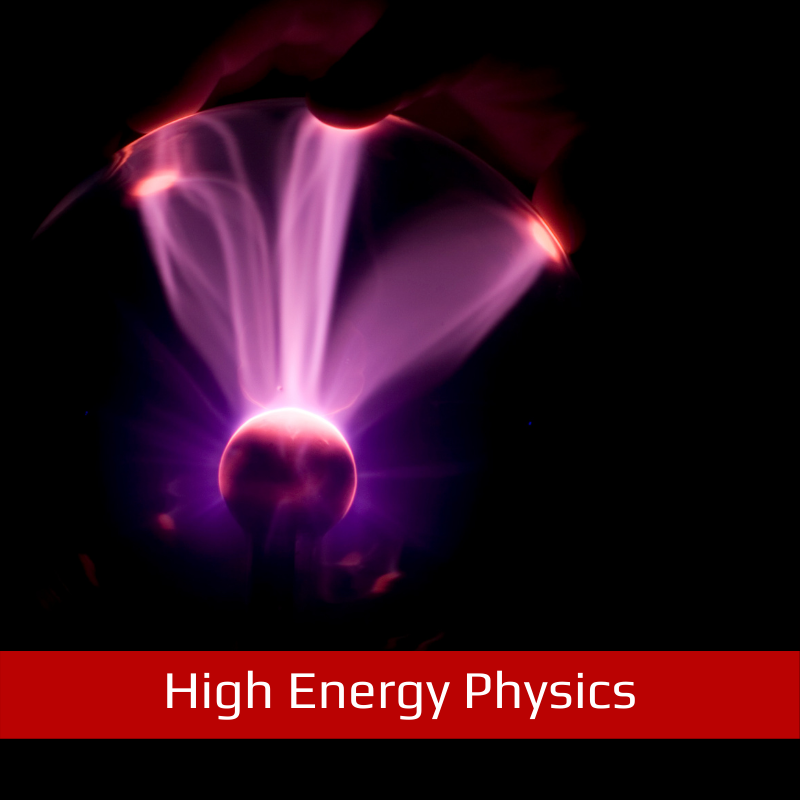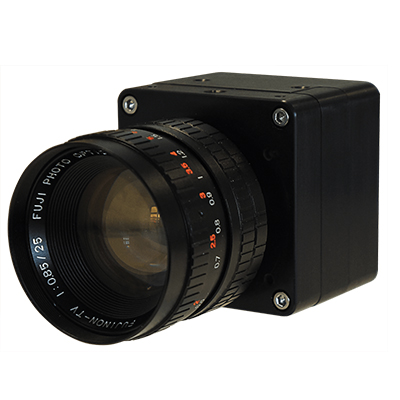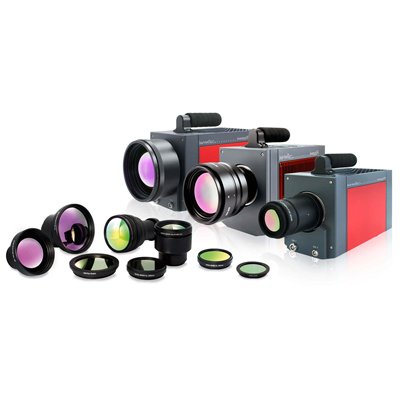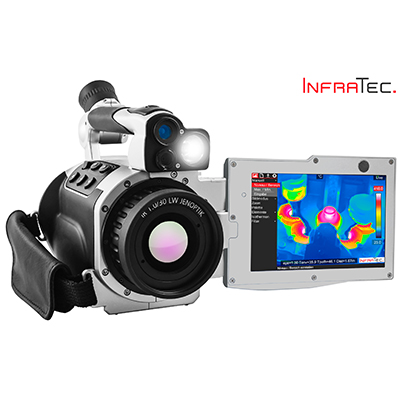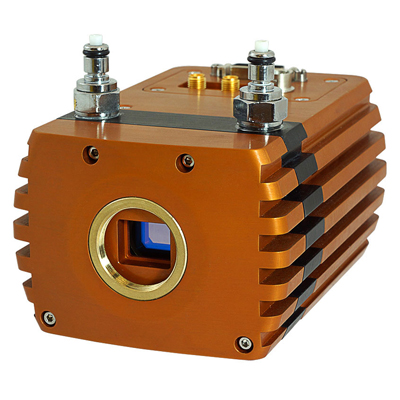- Features
- Models
- Videos
- Downloads
- Applications
- Related Products
- Contact
- Back To Spectroscopy
- Back To Optics
- Back To Hyperspectral
- Back To Cameras
- Back To X-Ray
- Back To Light Measurement
- Back To Characterisation
- Back To Electron Microscopy
- Back To Magnetometry
- Back To Ellipsometers
- Back To Cryogenics
- Back To Lake Shore
Cordin Scientific High Speed Imaging Cameras
High speed framing and streak imaging cameras
For over sixty years, Cordin has been at the pinnacle of high speed imaging and offers the fastest and highest quality scientific imaging systems in the world with the broadest product line of any high speed imaging provider. Cordin frequently works with end users to develop custom solutions to imaging challenges.
Cordin Scientific Imaging cameras provide high speed imaging solutions for situation that meet the following criteria:
- The event is visually observable and can be detected or triggered
- The event dynamics are in the sub-millisecond or sub-microsecond time domain
- The highest possible speed and resolution are required
- A record length of some hundred or fewer frames is adequate
A streak image is like a graph of one dimension of space over time. A streak camera captures a thin line of image information continuously at very fast rates. Cordin offers streak cameras using rotating mirror and image converter technologies. Cordin Image Converter Streak Cameras capture light information in the picosecond time domain. Cordin rotating mirror streak cameras capture images with a combination of speed and resolution unavailable anywhere else.
FEATURES
- Wide range of high speed imaging cameras with a temporal resolution in at the nanosecond scale down to picoseconds in some models
- High resolution pictures using frame and streak imaging techniques
- High frame rates achieved using rotating mirrors, gate intensified relaying, temporal pixel multiplexing, and image convertor relaying techniques
- A range of high speed and trigger based accessories to compliment high-speed imaging techniques
MODELS
Cordin Rotating Mirror Framing Cameras relay an image through a complex optical system centred around a rotating mirror, to multiple independent CCD camera modules. They capture the highest quality, highest resolution images at the fastest speeds compared to any other technology available:
- Framing rate up to 25 million fps
- Number of frames from 20 to 128
- Up to 29 Mpix Resolution
- 12-14 bit dynamic range
- Monochrome and colour modes
- Very low image noise
- Post trigger capacity
- Moderate sensitivity
- Large physical size
- Very high complexity
- Electric or gas turbine mirror drive
Model 560: 2 Mpix resolution, 4 million fps maximum speed, 20, 40, or 78 frame capture modes, continuous access triggering
Model 580: 8 Mpix resolution, 4 million fps maximum speed, 20, 40, or 78 frame capture modes, continuous access triggering
Model 521: 29 Mpix resolution, 2.5 million fps maximum speed, 24 frame capture, synchronous triggering
Model 510: 0.5 Mpix resolution, 25 million fps maximum speed, 128 frame capture, synchronous triggering
Cordin Gated Intensified Cameras relay an image through beam splitters to Micro-Channel Plate (MCP) intensifiers. These devices convert the incident photons of the image to an array of electrons, which are amplified and shuttered, and then directed to a phosphor. The resulting image is then captured on a CCD. The shuttering of the channels is done in a rapid sequence, capturing a series of images at very fast rates. They have very high sensitivity and extremely short exposure and interframe times. They are available with 2, 4, or 8 imaging channels, and can capture one or two images per channel:
- Framing rate up to 200 million fps
- Number of frames from 1 to 16
- Up to 4 Mpix resolution
- 4-8 bit dynamic range
- Monochrome imaging
- Moderate image noise
- Very high sensitivity
- Moderate physical size
- High complexity
- Model 212/214: 2, 4, or 8 images, 4 Mpix resolution, minimum exposure time of 15 ns or 2.5 ns, maximum speed of 66 million or 200 million fps
Model 222-4G: 8 or 16 images, 4 Mpix resolution, minimum exposure time of 2.5 ns, maximum speed of 200 million fps
Temporal Pixel Multiplexed (TPM) framing camera: The Cordin Model TPM-1000 high-speed CMOS camera offers a ground-breaking combination of 1-10 Mfps high-speed framing camera performance at a dramatic new pricepoint. The Cordin TPM-1000 captures images at frame rates of up to 10 million frames per second and up to 1 megapixel resolution. The system uses a new TPM architecture jointly developed by Cordin and Oxford University with a unique CMOS sensor chip capable of capturing sub-array images in a burst mode.
With its flexible TPM architecture, the TPM-1000 allows the user to trade off the number of frames in a burst versus resolution, given the available on-chip pixel memory.
The Model TPM-1000 camera can be triggered by the event being photographed, and can accept triggers in advance or for some time after the event of interest. It can also provide the trigger to initiate the event. The system comes complete with Cordin’s control software application, and is controlled via Ethernet interface by the customer’s choice of standard Windows-based PC or laptop. Data may be saved in a wide variety of 8 bit file formats. Full 10 bit images are saved in 16 bit TIFF file format.
- Framing rate up to 10 million fps
- Number of frames from 1 to 48 or more
- Up to 1 Mpix Resolution (1K x 1K pixels with 10 μm pitch)
- 10 bit dynamic range
- Monochrome imaging
- Low image noise
- High sensitivity
- Compact physical size
- Moderate complexity
- Solid state design with no moving parts
- Laser and pulsed flash illumination synchronisation
Cordin Rotating Mirror Streak Cameras relay a slit image through a rotating mirror to capture a continuous record of one line of image information. This produces the highest temporal and spatial resolution streak image possible. Cordin Rotating Mirror Streak Cameras have been a staple in leading labs for decades. The current models of digital cameras are a suitable replacement for and upgrade from the workhorse Cordin film streak cameras:
- Sub-nanosecond temporal resolution
- Very high spatial resolution
- 12 – 14 bit dynamic range
- Very low image noise
- High sensitivity
- Large physical size
- High complexity
- Applications [explosives testing, complex velocity measurements, impact ballistics, synchro-ballistic imaging]
Model 131: 3,250 pixel spatial resolution, temporal resolution down to 1.35 ns,
wiring rate up to 2,550 pixels/µs, record length up to 27,600 pixels (90 Mpix total)
Model 131 HD: 6,400 pixel spatial resolution, temporal resolution down to 0.65 ns,
wiring rate up to 6,700 pixels/µs, record length up to 46,000 pixels (295 Mpix total)
Cordin Image Converter Streak Cameras relay a slit image to the photocathode of an image converter tube, where the incident photons are converted to electrons. This linear array of electrons is then electrostatically focused and swept across a phosphor screen at the back of the tube, capturing light transients faster than any other method. The Cordin Model 164 Streak Camera is designed to provide very high performance at a competitive price:
- Picosecond temporal resolution
- Moderate spatial resolution, 4 – 8 bit dynamic range
- Moderate image noise
- Very high sensitivity
- Moderate physical size
- Moderate complexity
- Applications [time resolved spectroscopy, laser studies, optical communications, semiconductor physics]
Model 164: 25 line pair/mm spatial resolution, 20 picoseconds temporal resolution, 18 mm photocathode width, 4 Mpix readout resolution
Cordin light sources are designed to produce high intensity, square wave pulses where one pulse will cover the full record length of the camera.
Model 605:
- 0.5 – 10 milliseconds flash duration
- 5-10 million candela peak output
- operating voltage up to 900 V
- one or two flash heads
Model 606:
- 600 microseconds flash duration
- 10 million candela peak output
- operating voltage from 800 V to 1800 V
- one flash head
Model 607:
- 80 – 900 microseconds flash duration
- 30 million candela peak output
- 5 kV operating voltage
- one flash head
Cordin time delay generators have a clear user interface, high voltage outputs, and resolution down to 10 nanoseconds. They can be operated either through the front panel or through a graphical interface via USB connection:
- 10 nanoseconds – 99.99 milliseconds delay range
- 10 ns step size
- high voltage outputs at +30, +60, +90, or +125 V
Model 454 (4 channels)
Model 458 (8 channels)
Cordin’s Model 640 high voltage pulser is the industry standard for reliable, definite triggering of energetic events.
Model 640:
- TTL or +50V Input trigger
- +3 to +5 kV output voltage
- 850 ns response time
- 15 ns jitter
Cordin manufactures camera dollies specifically designed to be used with our cameras. We also make a range case for using the cameras in harsh environments.
Model 1500:
Adjustable Mobile Cart which supports 560, 580, 131, 131-HD, and 222 camera models
Videos
Downloads
Supplier Info
Military and Defence Research
- Explosive and detonation studies - Ballistic and projectile studies - Impact dynamics - Shape charge studies - Explosion front characterisation - Synchro-ballistic imaging
Nanotechnology
- Micromechanical machine dynamic analysis - Nanoscale material behaviour studies - Micro bubble studies
Hydrodynamics
- Hydroshock dynamics - Fluid cavitation - Aerosol and fuel injector studies - Droplet formation - Multi-phase flow dynamics




